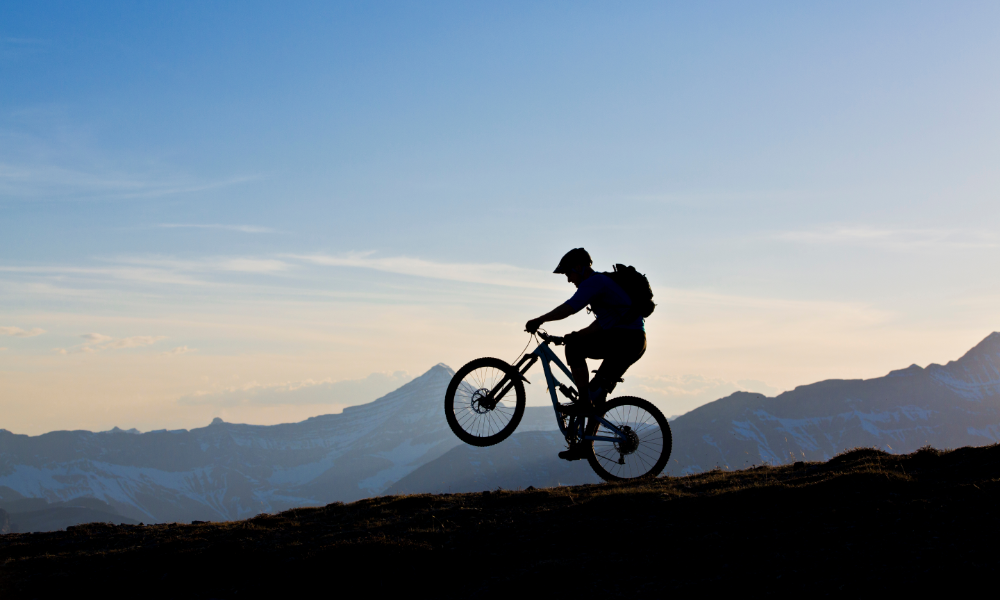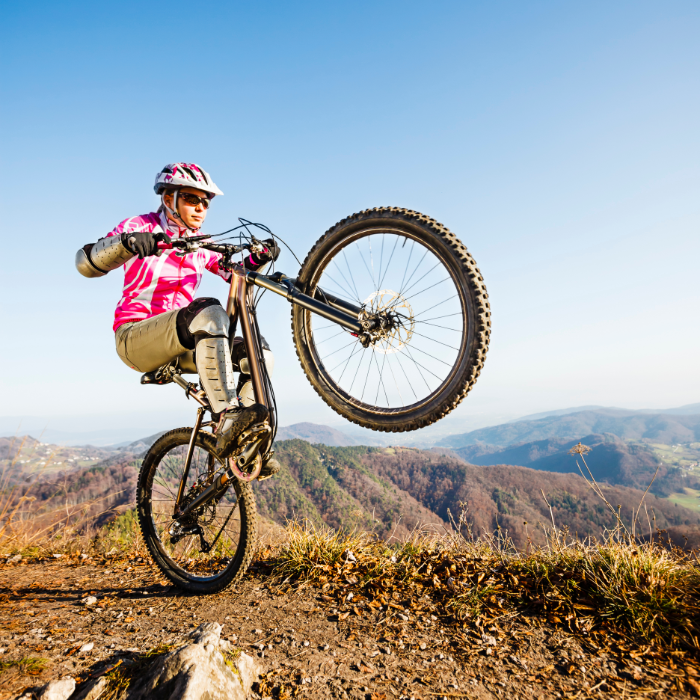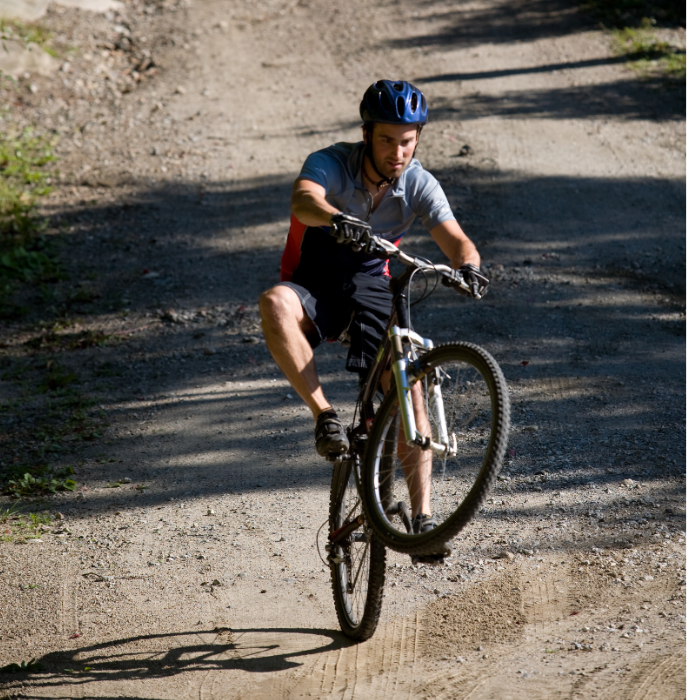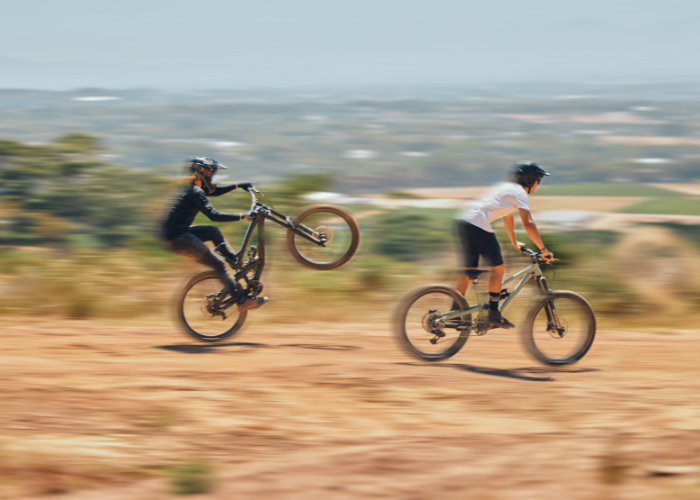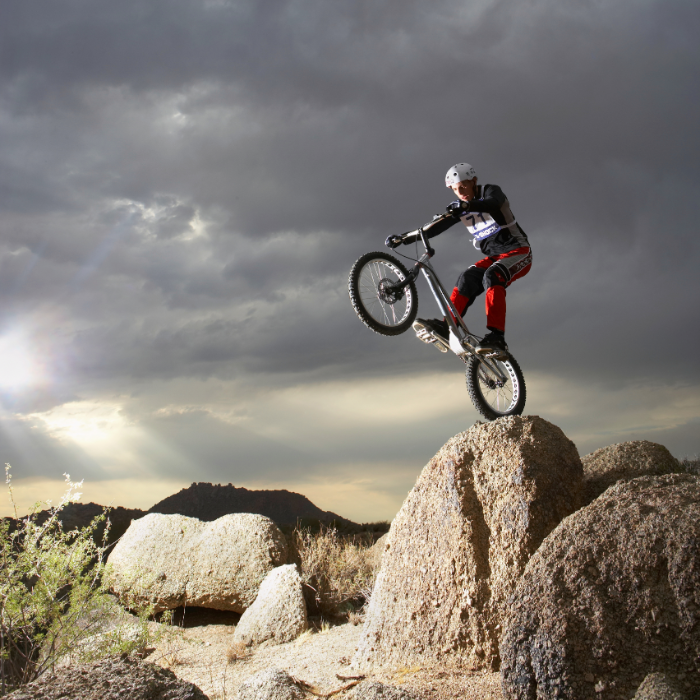Have you ever watched fellow riders effortlessly pop wheelies and wondered how you could achieve the same level of skill?
Wheelies are more than just a cool trick; they can actually enhance your mountain biking abilities by improving bike control and technical climbing skills.
In this guide, we’ll provide a step-by-step breakdown on how to wheelie a mountain bike, from essential safety gear to mastering the perfect technique.
Get ready to impress your friends and elevate your riding experience!
Key Takeaways
- Wear essential safety gear and optimize your bike setup for wheelie success.
- Master the art of wheelieing with practice on a manual machine and grass.
- Take your skills to the trails by experimenting with road grade, gear selection, brake control & more!
Essential Safety Gear
Before hopping on your mountain bike and attempting your first wheelie, it’s crucial to ensure you have the proper safety gear. A helmet is non-negotiable, as it protects you from potential severe injuries resulting from a wheelie gone wrong. When learning to wheelie, it’s also advisable to use flat pedals instead of clip-ins. This way, your feet can easily come off the pedals, preventing a nasty crash onto your back during a loop out on the rear wheel. Lastly, consider investing in back protection for added security and peace of mind while practicing this cool trick.
With the right safety gear in place, you can focus on perfecting your wheelie technique without worrying about potential risks. Remember, practice makes perfect, and wearing appropriate safety gear will allow you to practice with confidence.
Optimal Bike Set-Up
To set yourself up for wheelie success, it’s important to fine-tune your mountain bike for maximum performance, whether you’re mountain biking on a BMX bike or tackling rough terrain on mountain bikes. Three key aspects to consider are tire pressure, brake configuration, and saddle height, all of which contribute to your bike’s speed.
In the following subsections, we’ll delve into how each of these factors can impact your ability to perform wheelies and provide recommendations for optimal adjustments.
Tire Pressure
Tire pressure plays a significant role in your ability to balance during wheelies. Lowering tire pressure to around 25 PSI can greatly improve your control and balance. This is because lower pressure increases traction, allowing you to maintain control with your upper body during wheelies. Mountain bike tire pressure typically ranges from 22psi to 35psi, with the rear wheel often slightly higher than the front wheel.
Experiment with your tire pressure to find what works best for you, but be cautious not to go too low, as this can increase the chances of pinch flats or rim damage. Ultimately, finding the sweet spot between control and protection will set you on the path to wheelie mastery.
Brake Configuration
Proper brake setup is essential to wheelie a mountain bike, as it gives you the ability to precisely control the balance point during wheelies. To ensure your brakes are responsive and powerful, adjust the brake configuration accordingly. This allows you to maintain control, keeping your arms straight and avoiding looping out.
When setting up your brakes, make sure the brake lever is in a comfortable and easy-to-reach position. Check for consistent grab and sufficient brake pad life, as these factors are crucial for controlling the balance point during wheelies.
Saddle Height
Adjusting the saddle height is another important factor to consider when preparing for wheelies. Lowering the saddle 1-2 inches below its fully extended position can improve your control and balance during wheelies, making it easier to dismount and prevent looping out.
To find the best saddle height for wheelies, experiment with different positions and take note of how they affect your ability to maintain a stable wheelie. A lower saddle height will allow you to maintain the wheelie position more comfortably and make it easier to find the balance point.
Discovering Your Balance Point
Finding your balance point is a critical step in mastering the art of wheelieing. This point allows you to maintain control during the wheelie and keep it going for longer periods. Two effective ways to discover your balance point are using a manual machine and practicing on grass.
In the next subsections, we’ll explore how each method can help you develop the necessary skills to maintain control during wheelies.
Using a Manual Machine
A manual machine is an excellent tool for finding your balance point before attempting wheelies on pavement or trails. It provides a safe environment to practice rolling the bike forward and back while keeping your feet on the pedals, helping you identify the point where the bike starts to lift off the ground.
By practicing on a manual machine, you can become more familiar with the balance point, making it easier to find when you’re out on the trail performing wheelies. Building this foundation will give you confidence to tackle wheelies in more challenging environments.
Practicing on Grass
Another effective way to develop your balance point is by practicing wheelies on grass. The softer surface provides a forgiving environment to work on your reflexes, confidence, and balance. As you become more comfortable, you can gradually progress to harder surfaces and more challenging terrains.
Starting on a flat grass field is an excellent way to ease into wheelie practice. As your skills improve, you can challenge yourself by attempting wheelies on dirt or concrete paths going uphill. Remember, practice is key, and the more time you spend perfecting your wheelies on grass, the better equipped you’ll be to take your skills to the trail.
Mastering the Wheelie Technique
Now that you’ve covered the basics, it’s time to dive into the core techniques for executing a flawless wheelie. In this section, we’ll explore the essential components of the wheelie technique: preloading and pulling up, pedal power, and body positioning.
By mastering these elements, including the rear axle, you’ll be well on your way to becoming a wheelie expert, and not just a cool trick performer.
Preloading and Pulling Up
The first step to performing a wheelie is preloading the suspension by pushing down on the front of the bike. This action provides the necessary momentum to initiate the wheelie. To pull up effectively, use both your arms and torso, allowing for a powerful pedal stroke to lift the front wheel off the ground.
Avoid common mistakes such as only pulling up the front of the bike with your arms or relying solely on your torso to lift the front of your bike. Instead, harness the combined power of your arms and torso to execute a successful wheelie that showcases your skill and control, while maintaining balance on the back wheel.
Pedal Power
Pedal strokes play a crucial role in providing the power needed to lift the front wheel and maintain forward momentum during a wheelie. To get the most out of your strong pedal stroke, practice independently and combine them with preloading for best results.
Finding the right gear for your wheelie is essential, as it affects your ability to pedal and balance. Start with low-to-medium gear and adjust as needed for your specific terrain and skill level. As you gain confidence in your pedal power, you’ll be better equipped to maintain balance during wheelies and conquer any obstacles on the trail.
Body Positioning
Body positioning is a vital aspect of maintaining balance during wheelies, and chin placement plays a significant role in achieving this balance. Adjust your chin position to counteract front wheel drop or looping out, ensuring a stable and controlled wheelie.
Finding the perfect chin position may take some trial and error, but once you’ve mastered it, you’ll have the foundation to perform impressive wheelies with ease. Remember, proper body positioning is essential for maintaining control and balance, enabling you to take your wheelie skills to new heights.
Taking Your Wheelie Skills to the Trail
With the wheelie technique mastered, it’s time to take your skills to the trail. In this section, we’ll explore the factors to consider when transitioning from practice to real-world application. These include finding the ideal road grade, selecting the right gear, and controlling your brakes.
When selecting a road grade, it’s important to consider the terrain and the amount of road grade.
Ideal Road Grade
The perfect road grade for wheelies is a slight incline, approximately 6%. This grade allows for easier pedaling to maintain wheel lift and better control of speed, making it the optimal environment for practicing and perfecting your wheelie skills.
As you become more confident in your abilities, you can challenge yourself by attempting wheelies on steeper grades or varying terrain. Remember, practice is key, and continually pushing yourself to conquer new challenges will help you develop your wheelie prowess even further. To improve, it’s essential to practice wheelies consistently.
Gear Selection
Balancing pedaling and braking power is crucial for maintaining control during wheelies. Selecting the right gear can make all the difference in your ability to execute a successful wheelie. Start with low-to-medium gear, adjusting as needed based on the terrain and your skill level.
As you practice, you’ll find the optimal gear that provides just the right amount of resistance to pedal against while still allowing you to maintain control during your wheelie. Don’t be afraid to experiment with different gears to find the perfect balance for your unique riding style and environment.
Brake Control
Controlling your brakes is an essential aspect of executing a smooth and controlled wheelie. Modulate your rear brake to precisely adjust the height of your front wheel during the wheelie, and practice controlled set downs with the front brake.
By mastering brake control, you’ll be able to maintain a stable wheelie and perform smooth set downs, showcasing your skill and expertise on the trail. Remember, practice makes perfect, and the more time you spend honing your brake control, the more confident and skilled you’ll become.
Enhancing Your Wheelie Prowess
Now that you’ve mastered the wheelie technique and taken your skills to the trail, it’s time to focus on continuous improvement. To further enhance your wheelie prowess, dedicate time to practice, address balance issues early on, and experiment with different gears and terrain. By doing so, you’ll not only improve your wheelie skills, but also your overall bike control and technical climbing abilities.
Don’t be afraid to push yourself and explore new challenges in your wheelie journey. Whether it’s tackling steeper inclines, mastering counter steering, or practicing with fellow riders, the key to enhancing your wheelie prowess lies in your commitment to growth and development. Keep practicing, and soon you’ll be the envy of your fellow mountain bikers.
Summary
In conclusion, mastering the wheelie technique is not only an impressive skill, but also a valuable asset for enhancing your overall mountain biking abilities. From proper safety gear and bike setup to discovering your balance point and mastering the wheelie technique, we’ve covered the essential steps and tips to help you conquer this thrilling trick. Remember, practice is key, and as you continue to develop your wheelie skills, you’ll also improve your bike control and technical climbing prowess. So gear up, hop on your mountain bike, and start practicing those wheelies – the trail is waiting!
Frequently Asked Questions
What is the best gear for a wheelie?
For the perfect wheelie, first gear is your best friend. It’s the lowest gear and provides the most control for climbing hills and accelerating your motorcycle.
And if you want maximum power, use Power Wheels to give a boost to the front of the bike.
Start wheeling today!
Is doing a wheelie hard on bicycle?
Doing a wheelie on a bicycle takes plenty of skill and practice, as evidenced by the difficulty even professional cyclists have mastering it.
For those with persistence and determination to learn, it is an incredibly rewarding challenge.
What safety gear is essential for practicing wheelies?
To stay safe and have the best wheelie experience, you need to invest in some essential safety gear like a helmet, flat pedals, and back protection. Investing in these items is sure to give you the confidence to perform wheelies worry-free.
How can I adjust my mountain bike for optimal wheelie performance?
Take the time to adjust your tire pressure, brakes, and saddle height to ensure optimal wheelie performance. This combination of tweaks will help you achieve balance and maximum control when trying to pull off a wheelie.
What is the ideal road grade for practicing wheelies?
A 6% grade is ideal for practicing wheelies since it provides the perfect balance between allowing easier pedaling and better speed control.
